 Go
to the Archive index
Go
to the Archive indexIn 1953, Elswick-Hopper Cycles of Barton-upon-Humber found themselves approached by Trojan to construct a frame for testing their new 2-speed moped motor. This was completed and assessed at Elswick, who were disappointed to find the gearbox particularly crude and clumsy in operation. The machine was duly handed back to Trojan and was subsequently entered in the 1953 ACU 24-hour rally by Trojan Sales Manager Mr George Denton, to complete a creditable 303 miles and win a bronze medal.
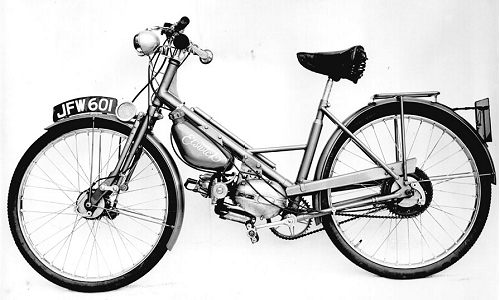
Elswick Trojan
Trojan's promotional seed however, seemed to have fallen on stony ground since there appeared no takers for options on the new engine, which disappeared, unnoticed. Maybe this left Elswick with the idea about making their own moped, and assessments began later to select a suitable engine. The Mosquito cyclemotor was ruled out on the basis that the direct roller drive was too primitive. A Dunkley-engined Elswick test frame, no SCO 1001, registered in July 1958, was running mileage on public roads, until it disgraced itself one day out at Skegness with a broken pushrod. Chief Engineer, Barry Wood was less than impressed at being stranded, and left with no option but to drag the wretched machine home on the train - so that was the end of the Dunkley!
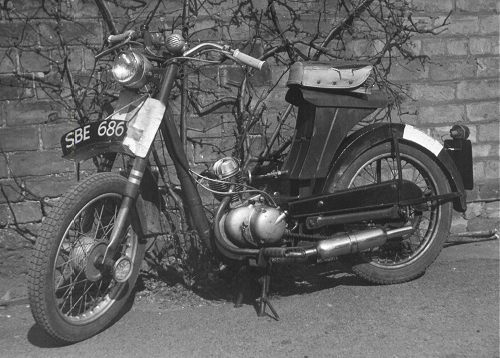
Elswick Dunkley
The star motor that emerged from the trials proved to be the VAP type 57, and it was this engine that formed the basis of the main test and development programme, up to July 1959, when six prototypes went for a week's testing at the MIRA proving ground. There were always ways round the strict confidentiality rules, and it seemed that Hercules's previous week of testing had been prematurely curtailed after only two days, by frame failures on the dreaded corrugated pavé surface (it is presumed these machines would have been prototypes of the Corvette).
Five of the Elswick VAPs survived their ordeals, with only one machine becoming sidelined from braze fracture of a fork brake anchor. In conclusion of a successful trial, several of the team testers reported obtaining ideal condition speedo readings up to an amazing best of 50mph on backwind runs around parts of the track! All the prototypes were tested with rigid cycle forks, excepting No 5, which initially tried an unsuccessful rubber block compression leading link, and later became modified to a short leading telescopic arrangement, though this too was considered unsatisfactory for production purposes.
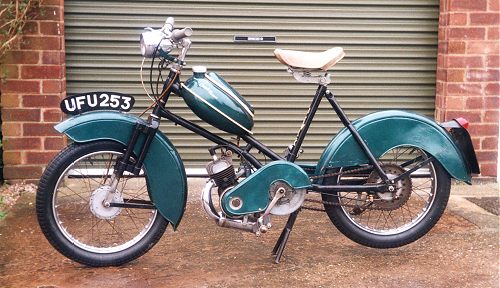
Elswick VAP prototype No 5, frame No A1004, the only
survivor from the test team
Fittings of the cycle assembly had become selected by Mr Hopfinger, consultant to the project, and comprised an assortment of proprietary components. Prior full width alloy hubs became laced into Dunlop 15×2½ rims and shod with 20" carrier grade tyres, being the same sizes adopted on several scooters by Mercury and Dunkley. Though slimmer in section, the substantial, panel-sided mudguards appear fairly similar to the Hermes, Dolphin and Popular scooter types in style of valance, and would undoubtedly have been very functional for their purpose. The 'bubble' petrol tank with its tool cover was the same one selected by Reynolds for their prototype mopeds, however, following-on from the Elswick test prototypes, it was preferred to relocate a VAP standard tank to underneath the seat for functional cleanliness reasons. Re-siting of the tank would have left the twin tube frame particularly bare, and in line with the vogue toward press formed frames, it was decided to box the main section within two panel halves. Along with the new chain and belt guard side-panel sets, these were tinsmithed out in the model shop, and no press tooling was ever made. The frame panel forms became styled to extend forward of the steering head, where they were ported to access the frame space as a cable tidy, and the forward joint closed by a large, enamel painted, shaped metal badge. The cycle parts were variously painted to a finish in two-tone blue, and graphics skilfully sign-written by Harold Hunsley. Nowhere on the new styling models was the name of Elswick Hopper to be seen - the machine had become ... The Lynx!
The front forks were remodelled to a trailing link of the engineering team's own design and manufacture, though a drafting error became introduced on the specification of the bottom link. When the 100 minimum batch of subcontract manufactured, machined and chrome plated castings arrived back at the works, it was discovered the front suspension jammed as the spring link pivot was located in the wrong position! Oops! The Earls Court clock was ticking and time running out to resolve the problem for the show, though it wasn't really going to matter that the forks didn't actually function since the two show machines would only be required to decorate the stand. The rule was always "dry tanks in the hall" so there would be no need for the machines to actually run.
Leaving the flashback for a moment, and standing before us 42 years on, is one of these very machines, somewhat deteriorated, a little incomplete, never registered and still never started! Now just press the 'instant restoration' button, and (eight months later) there we are - done! Ok, it's had to have a few missing bits remade, like both side-panels, the exhaust, petrol cap, pedal chain tensioner, and rear sprocket. Then that front suspension geometry sorted out, the engine stripped and serviced, seat rebuilt, lots of general fettling (isn't restoration easy in a few brief lines of text?), MoT, age related registration and we're just about ready to take our brand new Lynx for its first ride!
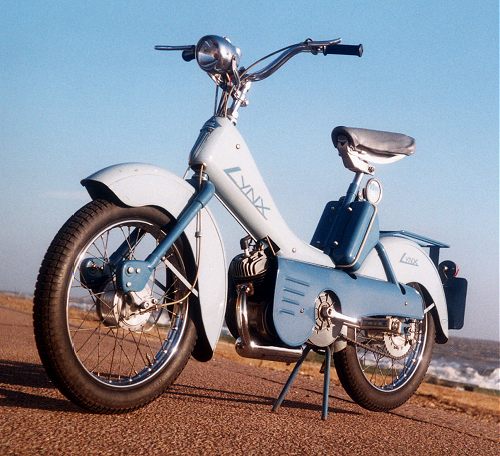
The Lynx
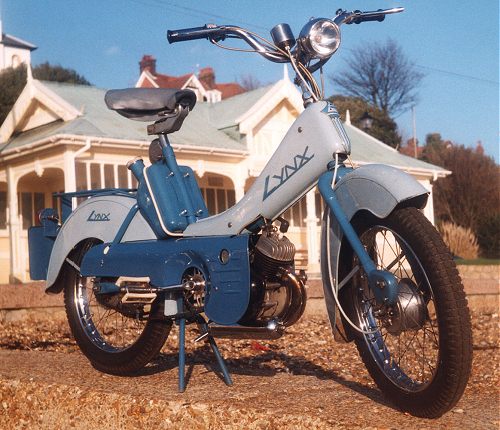
With 20" wheels and a 44T back sprocket, the Lynx works out at 6.7% higher geared than a conventional AutoVAP on 23" wheels with a 54T sprocket. This may be some contributory factor toward the prototype's ideal conditions performance at MIRA, but surely not 50mph from a 1.75bhp motor driving a fixed ratio! The best guess here is that the test prototypes were fitted with standard 23" speedo drives, so read 15% high. Allowing this deduction calculates down to 42mph, possibly being a somewhat more realistic expectation.
The Miller lighting fittings are driven from the VAP engine's Magneclair electrical set, being a particularly unusual device for the period in having no conventional round flywheel, so the plastic generator cover appears like a small rectangular box! The system features normal contact points with coil ignition, though in this case, its permanent magnetised poles remain static, and a small stator rotates within them! Following on with the inverse technology, flywheel effect is regained by the addition of a formed metal strip ringing the outside of the centrifugal clutch housing. Whatever the claimed capabilities of the unconventional Magneclair, in reality there barely seems enough power to dimly illuminate the 6V × 10W front & 5W rear bulbs. This wattage deficiency also carries over to the horn, which sounds less like a call of alarm, but more like a feeble cry for help from within the body panel. The unscrew-on petrol tap is located through a port in the middle top of the LH side-panel, with access being a bit snug, so you won't work it with your gloves on. Choke on the Gurtner D12mm carburettor is clicked on through another small finger-port at the front top of the RH panel, to snap off as the throttle is opened. The wire gauze air filter butts closely up against the inside face of the RH panel, so a circular porthole allows the carb to breathe from the outside world. A trigger decompressor easily gets the motor spinning and stops it with a loud twittering noise when you're done, so the general twist-&-go type operation is pretty conventional.
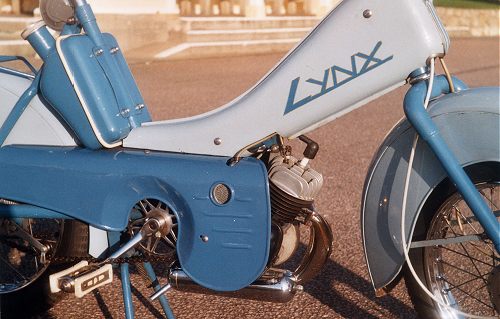
Following reconstruction and starting for the very first time on the stand, stand beside the bike and simply push down on one pedal; a cough on the first kick, then away and running on the second - not bad after over 40 years! Billowing clouds of smoke as you hold on the throttle to burn out the engine build oil, and tweak up the slide stop screw to find tick-over as the engine settles down. That VAP motor sounds superb; it's easy to see why Elswick ended up selecting it! So smooth and fresh with a crisp popping note from the silencer, and so mechanically quiet after all the familiar noises that emanate from Mobylette Dimoby clutches! On which point, a surprise discovery comes when stopping the Lynx and trying to navigate it about the garage. It moves backward on freewheel, but doesn't go forwards without turning the engine over! The reason for this is the drive to the motor is on a ratchet, and not clutched like a Moby. This goes to explain why the Lynx pedal drive engagement mechanism is so easily changed by simply clicking a disc-switch in the middle of the flywheel, while the Moby has a wretched fiddly thing that jams and everyone is very loathe to mess with! Initial take-off is best aided by some light pedal assistance as the single stage automatic clutch locks in quite readily and the high drive ratio works against it in this phase. Obviously not suited to take-offs on an incline! The motor though, pulls quite steadily and soon eases you up to a very pleasant cruising pace of 20-25 mph, at which it seems to encapsulate the whole feeling of the late 50s and early 60s. Super-DeLuxe-a-Matic! Some vibrations start to creep through the machine above this speed, becoming noticeable in the buzzing of the various body panels and through the Tarantula rubber saddle, so the general tendency is not to run the bike much quicker for very long. The motor itself runs smoothly and cleanly while pulling under throttle, but readily breaks into 4-stroking on light load, though the effect is quite muffled and not intrusive. The open ported carb surprises in its unobtrusive intake draw, so the laminated wire gauze filter proves fairly effective in damping out the sound.
The cycle frame is a rigid rear, and you'd think the front end was as well. Despite their technical appearance, those undeveloped trailing link forks prove to be way oversprung and the links generally remain firmly against the downstop buffers. The steering is also quite light, and there's a tendency for the machine to wander somewhat, which requires the rider to compensate by a little more concentration to pilot a straight course. Cornering under power at speed is very confident thanks to the 4-ply × 2½" wide tyres, much firmer than any comparative moped, and more like a light motor cycle! While the excellent full width Prior alloy hubs deliver the expected braking performance, the effect is completely ruined by the behaviour of those forks. Under front braking the nose dives, to kick back hard against the stops again as the machine slows or the brake is released. The same effect also occurs every time one hits larger bumps or potholes, and you very quickly wish the bike had some other arrangement. The other reaction when spring compression takes the links off the downstops is that change in state suddenly makes the fork-set feel rather unstable. There's no damping system in this action either, so the whole front suspension function becomes a fairly disconcerting experience for the rider. It takes quite a bit of getting used to, and never feels particularly right. It's unlikely to see that Elswick's testers would have recommended the system into production - that's if they'd had the opportunity to prove it! Thrashed mercilessly, crouched, on long downhill stretches, top speed achieved is 36 - 37mph, confirmed with a pace machine, at which the engine was revving smoothly and confidently (having gone through the vibration band), so that completely explodes the myth on the speed capability.
Visually unusual, though a striking looker, the Lynx would probably be comparable with the contemporary belt and chain drive Raleigh RM4, Hercules Corvette, VAPs and basic Mobylettes - but how would it fare in the market place against the competition? The two show models really did grace the hallowed halls of Earls Court in November 1960, on Stand 83, though merely listed among "Auto-VAP, Capri, Como, Honda, Laverda, Lynx, Velo-VAP". No launch announcement, no press release - just a couple of cats in the crowd, and probably few people even noticed they were there! It was almost as if there was no real interest in actually selling the Lynx, so what had happened? Stand 83 didn't even represent the Barton works, but bore the name of Scootamatic Ltd with a London office, Sales & Service Headquarters in Nottingham, and 7 regional service centres (interestingly, one of which became located at National Works, Hounslow, the former Dunkley site!) Formed by the management of Elswick Hopper, Scootamatic was a new company specially set up to handle sales of the above listed imported mopeds and scooters (though they actually declined the Honda, thinking it wouldn't sell - a bit like Decca Records failing to sign The Beatles!) Having finally estimated the Lynx at a manufactured cost of £58, it was coming out significantly more than the purchase cost of factoring a comparative AutoVAP (the Caravelle model was actually being listed for £56 13s Od at this time!), so it looked like the obvious decision had already been made. In terms of wider practicalities, the two Lynx were no more than display models, and no capable tooling existed to actually make them. Scootamatic were hardly in a position to have been able to accept any orders on them at the show! Though the two frame side-covers and both side-panels were being planned to run on their 90ton press, in reality, it would have been difficult to see Elswick finding the financial justification required for the considerable outlay to cover the cost of the full tooling suite. Besides which, the model panel forms were still not even developed for practical production manufacture! Maybe if Elswick had decided to go with the basic, original prototype format a bit earlier, then things could have been different. The rigid cycle forks and simple fittings would have been much more economic, well within the general manufacturing capability, and without the crippling tooling outlay.
Evolution into the Lynx developed beyond practicality, and in the cold light of day, there was little real chance of the machine ever reaching production; nevertheless, the two models stood for a while longer as ornaments in the company foyer. Despite assembling VAPs (which were serialised as a continuation of the Elswick frame numbers!) and Capri scooters from St Mary's Works, Barton, the factored profits at Scootamatic contributed little to Elswick Hopper, and this work came to an end in 1966. By 1968, Coventry Eagle (which became Falcon Cycles) took a lease on some of the buildings, and as the Elswick factory site became progressively cleared, local enthusiasts managed to rescue the two historic Lynxes, which thankfully both survive. The other Lynx, frame no A10??, became registered in 1968 and was used locally for a few years, before being restored and preserved, still in its home town of Barton. The old factory buildings still stand, chiefly occupied by Meldan petrochemical industrial fabricators. The 1911 assembly shop currently sees little use under M&M Picture Frame Mouldings Ltd; Coles Engineering occupy a small machining workshop at the site off Marsh Lane, while the Soutergate entrance is home to general engineers WM Codd, and Beck Hill Motors garage. Elswick Hopper continued beyond the cycle trade, moving into agricultural and packaging machinery as Elswick plc, before eventually falling into receivership by year 2000. Then finally, after all this time, the last piece of the jigsaw, the second Lynx, frame no A 1014 takes to the highway - a little piece of history now out on the NACC rally circuit.
This article was first published in February 2003. Since the article was written, another surviving example of the six Elswick-VAP prototypes - number 6 - has been discovered and more information has been uncovered. A revised and updated article on the Elswick-Hopper Lynx was published on the Iceni CAM Website in November 2008.
"Old Dan" the innkeeper started building velocipedes in 1868 from his workshop at the back of the Tigers Head. By 1914 the senior TT had fallen to "The Red Hand", and in April 2003 Buzzing is set to test the last machine from this glorious company. Dust off your history books to pick-up this thread.